Surface and Interface Investigation of a 15th Century Wall Painting Using Multispectral Imaging and Pulse-Compression Infrared Thermography
Abstract
1. Introduction
2. Materials and Methods
2.1. Inspected Artwork: Wall Painting from Antonio del Massaro, known as Pastura
2.2. Hypercolorimetric Multispectral Imaging (HMI)
2.3. X-ray Fluorescence Spectroscopy (XRF)
2.4. Pulse-Compression Thermography (PuCT)
3. Results and Discussion
3.1. Hypercolorimetric Multispectral Imaging (HMI)
3.2. X-ray Fluorescence Spectroscopy
3.3. Pulse-Compression Thermography (PuCT)
4. Conclusions
Author Contributions
Funding
Institutional Review Board Statement
Informed Consent Statement
Data Availability Statement
Acknowledgments
Conflicts of Interest
Abbreviations
| HMI | Hypercolorimetric multispectral imaging |
| PuCT | Pulse-compression thermography |
| CH | Cultural Heritage |
| MS | Multispectral |
| HS | Hyperspectral |
| UV | Ultraviolet |
| VIS | Visible |
| IR | Infrared |
| TTR | Terahertz time resolved |
| OCT | Optical coherence tomography |
| IRT | Infrared thermography |
| UVF | Ultraviolet fluorescence |
| LED | Light emitting diode |
| AWG | Arbitrary waveform generator |
| PCA | Principal component analysis |
| SNR | Signal-to-noise ratio |
| PuC | Pulse-compression |
| GUI | Graphical user interface |
| IRFC | Infrared false colour |
References
- Mairinger, F. UV-, IR-and X-ray imaging. In Non-Destructive Microanalysis of Cultural Heritage Materials; Janssens, K., Van Grieken, R., Eds.; Elsevier Science: Amsterdam, The Netherlands, 2004; Volume XLII, pp. 15–73. [Google Scholar]
- Kubik, M. Hyperspectral imaging: A new technique for the non-invasive study of artworks. In Physical Techniques in the Study of Art, Archaeology and Cultural Heritage; Creagh, D., Bradley, D., Eds.; Elsevier: Amsterdam, The Netherlands, 2007; Volume 2, pp. 199–259. [Google Scholar]
- Aldrovandi, A.; Bertani, D.; Cetica, M.; Matteini, M.; Moles, A.; Poggi, P.; Tiano, P. Multispectral image processing of paintings. Stud. Conserv. 1988, 33, 154–159. [Google Scholar] [CrossRef]
- Saunders, D.; Billinge, R.; Cupitt, J.; Atkinson, N.; Liang, H. A new camera for high-resolution infrared imaging of works of art. Stud. Conserv. 2006, 51, 277–290. [Google Scholar] [CrossRef]
- Fischer, C.; Kakoulli, I. Multispectral and hyperspectral imaging technologies in conservation: Current research and potential applications. Stud. Conserv. 2006, 51, 3–16. [Google Scholar] [CrossRef]
- Delaney, J.K.; Zeibel, J.G.; Thoury, M.; Littleton, R.O.; Palmer, M.; Morales, K.M.; de La Rie, E.R.; Hoenigswald, A. Visible and infrared imaging spectroscopy of Picasso’s Harlequin musician: Mapping and identification of artist materials in situ. Appl. Spectrosc. 2010, 64, 584–594. [Google Scholar] [CrossRef] [PubMed]
- Adam, A.J.L.; Planken, P.C.M.; Meloni, S.; Dik, J. Terahertz imaging of hidden paint layers on canvas. Opt. Express 2009, 17, 3407–3416. [Google Scholar] [CrossRef]
- Fukunaga, K.; Picollo, M. Terahertz spectroscopy applied to the analysis of artists’ materials. Appl. Phys. A 2010, 100, 591–597. [Google Scholar] [CrossRef]
- Casini, A.; Bacci, M.; Cucci, C.; Lotti, F.; Porcinai, S.; Picollo, M.; Radicati, B.; Poggesi, M.; Stefani, L. Fiber optic reflectance spectroscopy and hyper-spectral image spectroscopy: Two integrated techniques for the study of the Madonna dei Fusi. In Proceedings of the Optical Methods for Arts and Archaeology, Munich, Germany, 13–17 June 2005. [Google Scholar]
- Elias, M.; Mas, N.; Cotte, P. Review of several optical non-destructive analyses of an easel painting. Complementarity and crosschecking of the results. J. Cult. Herit. 2011, 12, 335–345. [Google Scholar] [CrossRef]
- Luciani, G.; Pelosi, C.; Agresti, G.; Lo Monaco, A. How to reveal the invisible the fundamental role of diagnostics for religious painting investigation. Eur. J. Sci. Theol. 2019, 15, 209–220. [Google Scholar]
- Lanteri, L.; Agresti, G.; Pelosi, C. A new practical approach for 3D documentation in ultraviolet fluorescence and infrared reflectography of polychromatic sculptures as fundamental step in restoration. Heritage 2019, 2, 207–215. [Google Scholar] [CrossRef]
- Colantonio, C.; Pelosi, C.; D’Alessandro, L.; Sottile, S.; Calabrò, G.; Melis, M. Hypercolorimetric multispectral imaging system for cultural heritage diagnostics: An innovative study for copper painting examination. Eur. Phys. J. Plus 2018, 133, 526. [Google Scholar] [CrossRef]
- Pelosi, C.; Calienno, L.; Fodaro, D.; Borrelli, E.; Rubino, A.R.; Sforzini, L.; Lo Monaco, A. An integrated approach to the conservation of a wooden sculpture representing Saint Joseph by the workshop of Ignaz Günther (1727–1775): Analysis, laser cleaning and 3D documentation. J. Cult. Herit. 2016, 17, 114–122. [Google Scholar] [CrossRef]
- Lo Monaco, A.; Giagnacovo, C.; Falcucci, C.; Pelosi, C. The triptych of the Holy Saviour in the Tivoli Cathedral: Diagnosis, conservation and religious requirements. Eur. J. Sci. Theol. 2015, 11, 241–252. [Google Scholar]
- Pelosi, C.; Falcucci, C.; Ardagna, V. Investigation of a medieval illuminated manuscript through non-invasive techniques. Eur. J. Sci. Theol. 2017, 13, 61–68. [Google Scholar]
- Vetter, W.; Schreiner, M. Characterization of pigment binding media systems—Comparison of non invasive in situ reflection FTIR with transmission FTIR microscopy. e-Preservation Sci. 2011, 8, 10–22. [Google Scholar]
- Ricciardi, P.; Delaney, J.K.; Facini, M.; Zeibel, J.G.; Picollo, M.; Lomax, S.; Loew, M. Near infrared reflectance imaging spectroscopy to map paint binders in situ on illuminated manuscripts. Angew. Chem. Int. Ed. 2012, 51, 5607–5610. [Google Scholar] [CrossRef]
- Legrand, S.; Ricciardi, P.; Nodari, L.; Janssens, K. Non-invasive analysis of a 15th century illuminated manuscript fragment: Point-based vs imaging spectroscopy. Microchem. J. 2018, 138, 162–172. [Google Scholar] [CrossRef]
- Mancini, D.; Percot, A.; Bellot-Gurlet, L.; Colomban, P.; Carnazza, P. On-site contactless surface analysis of modern paintings from Galleria Nazionale (Rome) by Reflectance FTIR and Raman spectroscopies. Talanta 2021, 227, 122159. [Google Scholar] [CrossRef] [PubMed]
- Laureti, S.; Malekmohammadi, H.; Rizwan, M.K.; Burrascano, P.; Sfarra, S.; Mostacci, M.; Ricci, M. Looking through paintings by combining hyper-spectral imaging and pulse-compression thermography. Sensors 2019, 19, 4335. [Google Scholar] [CrossRef]
- Rosi, F.; Miliani, C.; Braun, R.; Harig, R.; Sali, D.; Brunetti, B.G.; Sgamellotti, A. Noninvasive analysis of paintings by mid-infrared hyperspectral imaging. Angew. Chem. Int. Ed. 2013, 52, 5258–5261. [Google Scholar] [CrossRef]
- Melis, M.; Miccoli, M.; Quarta, D. Multispectral hypercolorimetry and automatic guided pigment identification: Some masterpieces case studies. Proceedings Optics for Arts, Architecture, and Archaeology IV, Munich, Germany, 13–16 June 2013. [Google Scholar]
- Samadelli, M.; Melis, M.; Miccoli, M.; Vigl, E.E.; Zink, A.R. Complete mapping of the tattoos of the 5300-year-old Tyrolean Iceman. J. Cult. Herit. 2015, 16, 753–758. [Google Scholar] [CrossRef]
- Melis, M.; Miccoli, M. Trasformazione evoluzionistica di una fotocamera reflex digitale in un sofisticato strumento per misure fotometriche e colorimetriche. Proceedings Colore e Colorimetria contributi multidisciplinari, Firenze, Italy, 19–20 September 2013. [Google Scholar]
- Dong, J.; Locquet, A.; Melis, M.; Citrin, D.S. Global mapping of stratigraphy of an old-master painting using sparsity-based terahertz reflectometry. Sci. Rep. 2017, 7, 15098. [Google Scholar] [CrossRef] [PubMed]
- Alberghina, M.F.; Macchia, A.; Capizzi, P.; Schiavone, S.; Ruffolo, S.A.; Comite, V.; Barberio, M.; La Russa, M.F. Surface and volume non-invasive methods for the structural monitoring of the bass-relief ‘Madonna con Bambino’ (Gorizia, Northern Italy). Nat. Prod. Res. 2019, 33, 1034–1039. [Google Scholar] [CrossRef]
- Elkhuizen, W.S.; Callewaert, T.W.J.; Leonhardt, E.; Vandivere, A.; Song, Y.; Pont, S.C.; Geraedts, J.M.P.; Dik, J. Comparison of three 3D scanning techniques for paintings, as applied to Vermeer’s ‘Girl with a Pearl Earring’. Herit. Sci. 2019, 7, 1–22. [Google Scholar] [CrossRef]
- Zhang, H.; Sfarra, S.; Saluja, K.; Peeters, J.; Fleuret, J.; Duan, Y.; Fernandes, H.; Avdelidis, N.; Ibarra-Castanedo, C.; Maldague, X. Non-destructive investigation of paintings on canvas by continuous wave terahertz imaging and flash thermography. J. Nondestruct. Eval. 2017, 36, 34. [Google Scholar] [CrossRef]
- Maldague, X. Theory and Practice of Infrared Thermography for Nondestructive Testing; Wiley: Hoboken, NJ, USA, 2001. [Google Scholar]
- Bodnar, J.L.; Nicolas, J.L.; Candoré, J.C.; Detalle, V. Non-destructive testing by infrared thermography under random excitation and ARMA analysis. Int. J. Thermophys. 2012, 33, 2011–2015. [Google Scholar] [CrossRef]
- Silipigni, G.; Burrascano, P.; Hutchins, D.A.; Laureti, S.; Petrucci, R.; Senni, L.; Torre, L.; Ricci, M. Optimization of the pulse-compression technique applied to the infrared thermography nondestructive evaluation. NDT & E Int. 2017, 87, 100–110. [Google Scholar] [CrossRef]
- Laureti, S.; Sfarra, S.; Malekmohammadi, H.; Burrascano, P.; Hutchins, D.A.; Senni, L.; Silipigni, G.; Maldague, X.P.V.; Ricci, M. The use of pulse-compression thermography for detecting defects in paintings. NDT & E Int. 2018, 98, 147–154. [Google Scholar] [CrossRef]
- Sfarra, S.; Laureti, S.; Gargiulo, G.; Malekmohammadi, H.; Sangiovanni, M.A.; La Russa, M.; Burrascano, P.; Ricci, M. Low Thermal Conductivity Materials and Very Low Heat Power: A Demanding Challenge in the Detection of Flaws in Multi-Layer Wooden Cultural Heritage Objects Solved by Pulse-Compression Thermography Technique. Appl. Sci. 2020, 10, 4233. [Google Scholar] [CrossRef]
- Laureti, S.; Colantonio, C.; Burrascano, P.; Melis, M.; Calabrò, G.; Malekmohammadi, H.; Sfarra, S.; Ricci, M.; Pelosi, C. Development of integrated innovative techniques for paintings examination: The case studies of The Resurrection of Christ attributed to Andrea Mantegna and the Crucifixion of Viterbo attributed to Michelangelo’s workshop. J. Cult. Herit. 2019, 40, 1–16. [Google Scholar] [CrossRef]
- Gittins, M.; Agresti, G.; Catalano, M.I.; Pelosi, C.; Pogliani, P. La lunetta raffigurante Madonna con Bambino in trono tra gli angeli e i Santi Francesco e Girolamo staccato dal convento di Santa Maria del Paradiso per il Museo Civico di Viterbo: Fortuna dell’opera e storia conservativa alla luce dell’ultimo restauro (2016-2017). In Proceedings of the XV Congresso Nazionale IGIIC Lo Stato dell’Arte, Firenze, Italy, 12–14 October 2017. [Google Scholar]
- Ricci, C. Antonio da Viterbo detto il Pastura e l’Appartamento Borgia. Per l’inaugurazione del Museo Civico di Viterbo; Agnesotti: Viterbo, Italy, 1912; pp. 23–27. [Google Scholar]
- Zuccari, A. L’attività viterbese di Antonio del Massaro detto il Pastura. Il Quattrocento a Viterbo; Museo Civivo di Viterbo: Milano, Italy, 1983; pp. 222–239. [Google Scholar]
- Rinaldi, S. I dipinti del Museo Civico di Viterbo. Censimento conservativo in omaggio a Michele Cordaro; Ediart: Todi, Italy, 2004; p. 75. [Google Scholar]
- Pelosi, C.; Lanteri, L.; Agresti, G.; Santamaria, U. Documentation and Scientific Investigation on the “Crucifixion” by Balletta in the church of Santa Maria Nova in Viterbo (Italy). Conservation and Religious Requirements. Eur. J. Sci. Theol. 2016, 12, 271–281. [Google Scholar]
- Lanteri, L.; Agresti, G. Ultraviolet fluorescence 3D models for diagnostics of cultural heritage. Eur. J. Sci. Theol. 2017, 13, 35–40. [Google Scholar]
- Derrick, M.R.; Stulik, D.C.; Landry, J.M. Infrared spectroscopy in conservation science, 1st ed.; The Getty Conservation Institute: Los Angeles, CA, USA, 1999; Chapters 2–6. [Google Scholar]
- Meilunas, R.J.; Bentsen, J.G.; Steinberg, A. Analysis of aged paint binders by FTIR spectroscopy. Stud. Conserv. 1990, 35, 33–51. [Google Scholar] [CrossRef]
- Melis, M.; Babbi, A.; Miccoli, M. Development of a UV to IR extension to the standard colorimetry, based on a seven band modified DSLR camera to better characterize surfaces, tissues and fabrics. In Proceedings of the SPIE Optical Metrology, Optics for Arts Architecture, and Archaeology III, Munich, Germany, 23–26 May 2011. [Google Scholar]
- Bro, R.; Smilde, A.K. Principal component analysis. Anal. Methods 2014, 6, 2812–2831. [Google Scholar] [CrossRef]
- Pelosi, C.; Capobianco, G.; Agresti, G.; Bonifazi, G.; Morresi, F.; Rossi, S.; Santamaria, U.; Serranti, S. A methodological approach to study the stability of selected watercolours for painting reintegration, through reflectance spectrophotometry, Fourier transform infrared spectroscopy and hyperspectral imaging. Spectroch. Acta A 2018, 198, 92–106. [Google Scholar] [CrossRef] [PubMed]
- Lau, D.; Villis, C.; Furman, S.; Livett, M. Multispectral and hyperspectral image analysis of elemental and micro-Raman maps of cross-sections from a 16th century painting. Anal. Chim. Acta 2008, 610, 15–24. [Google Scholar] [CrossRef] [PubMed]
- Cosentino, A. Infrared technical photography for art examination. e-Preserv. Sci. 2016, 13, 1–6. [Google Scholar]
- Cosentino, A. Identification of pigments by multispectral imaging; a flowchart method. Herit. Sci. 2014, 2, 8. [Google Scholar] [CrossRef]
- Cosentino, A. Effects of different binders on technical photography and reflectrography of 54 historical pigments. Int. J. Conserv. Sci. 2015, 6, 287–298. [Google Scholar]
- Cavallo, G. Alteration of azurite into paratacamite at the St. Alessandro church (Lasnigo, Italy). Conserv. Patrim. 2009, 9, 5–11. [Google Scholar] [CrossRef][Green Version]
- Sandu, I.C.; Afonso, L.U.; Murta, E.; de Sa, M.H. Gilding techniques in religious art between east and west, 14th–18th centuries. Int. J. Conserv. Sci. 2010, 1, 47–62. [Google Scholar]
- Seccaroni, C.; Moioli, P. Prontuario per L’analisi XRF Portatile Applicata a Superfici Policrome, 1st ed.; Nardini Editore: Firenze, Italy, 2002; p. 69. [Google Scholar]
- Liu, C.; van Netten, J.J.; Van Baal, J.G.; Bus, S.A.; van Der Heijden, F. Automatic detection of diabetic foot complications with infrared thermography by asymmetric analysis. J. Biomed. Opt. 2015, 20, 026003. [Google Scholar] [CrossRef] [PubMed]
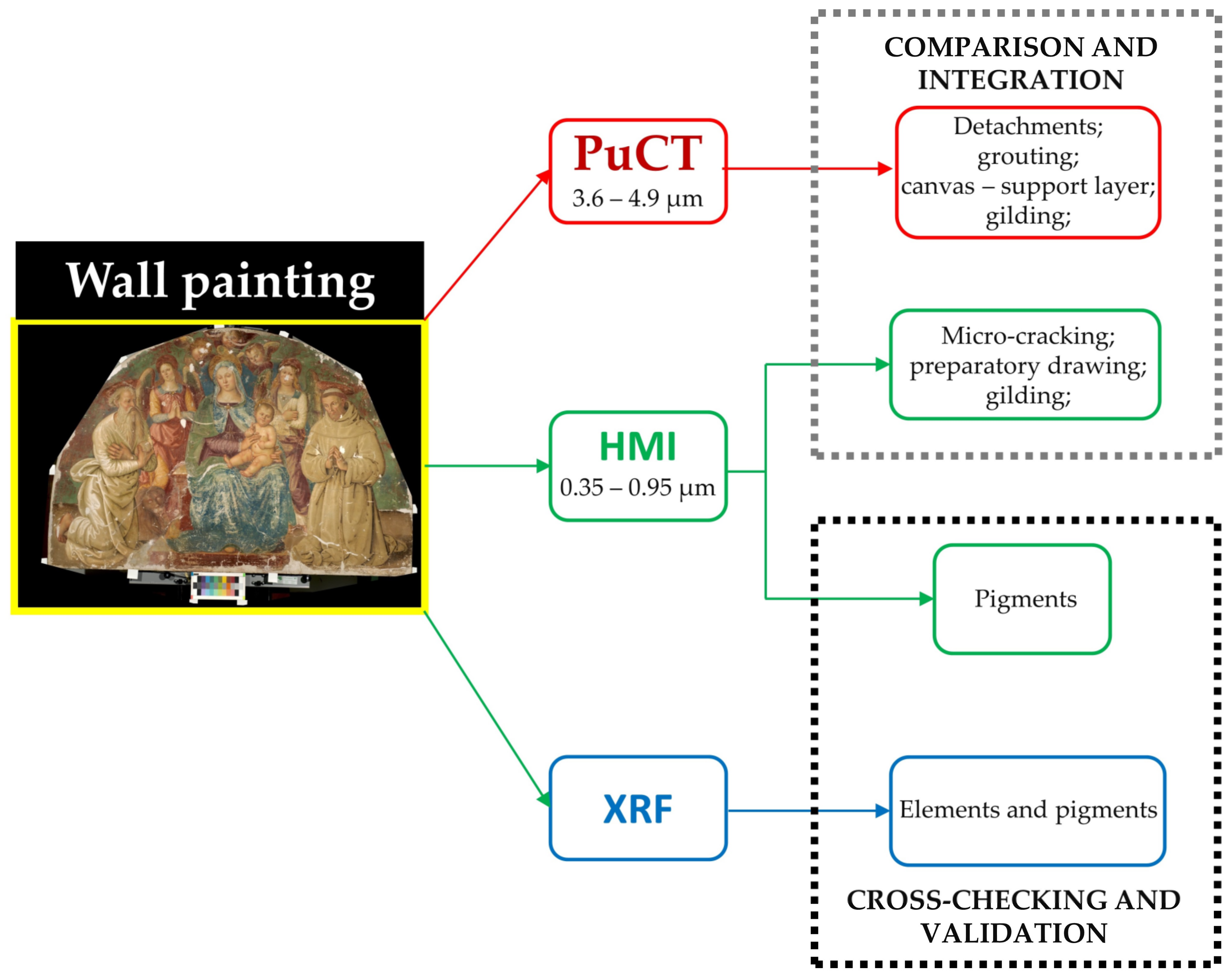
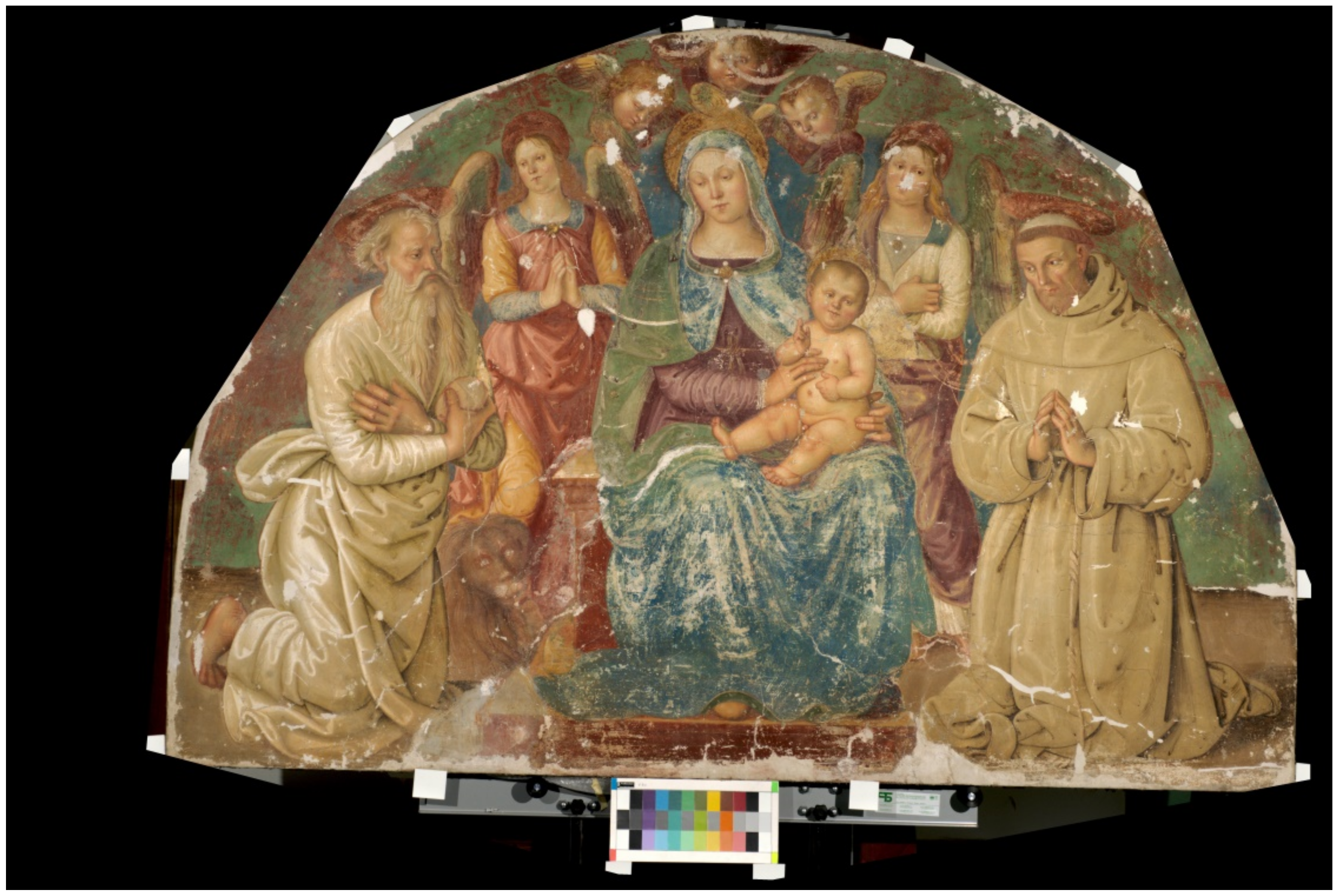
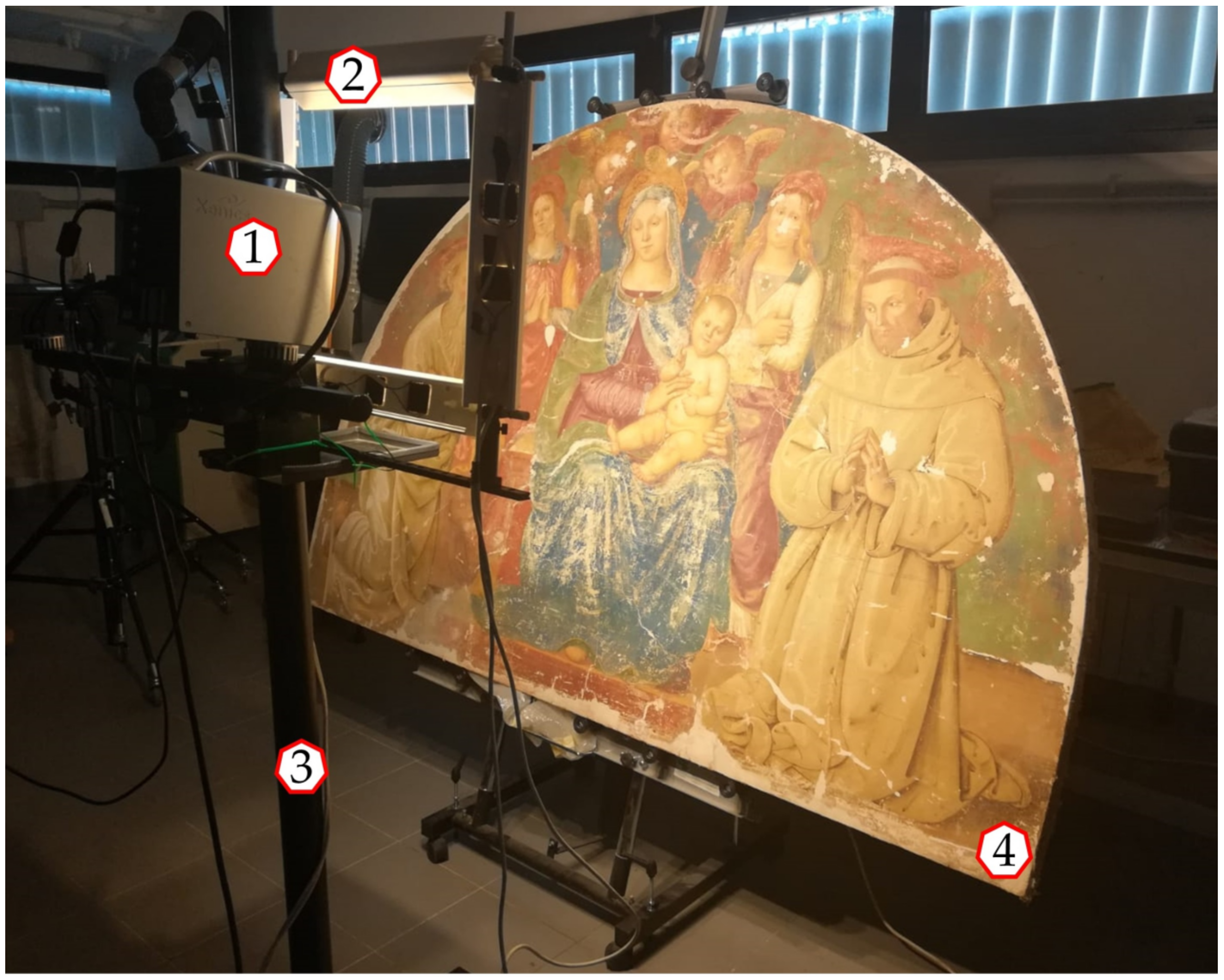
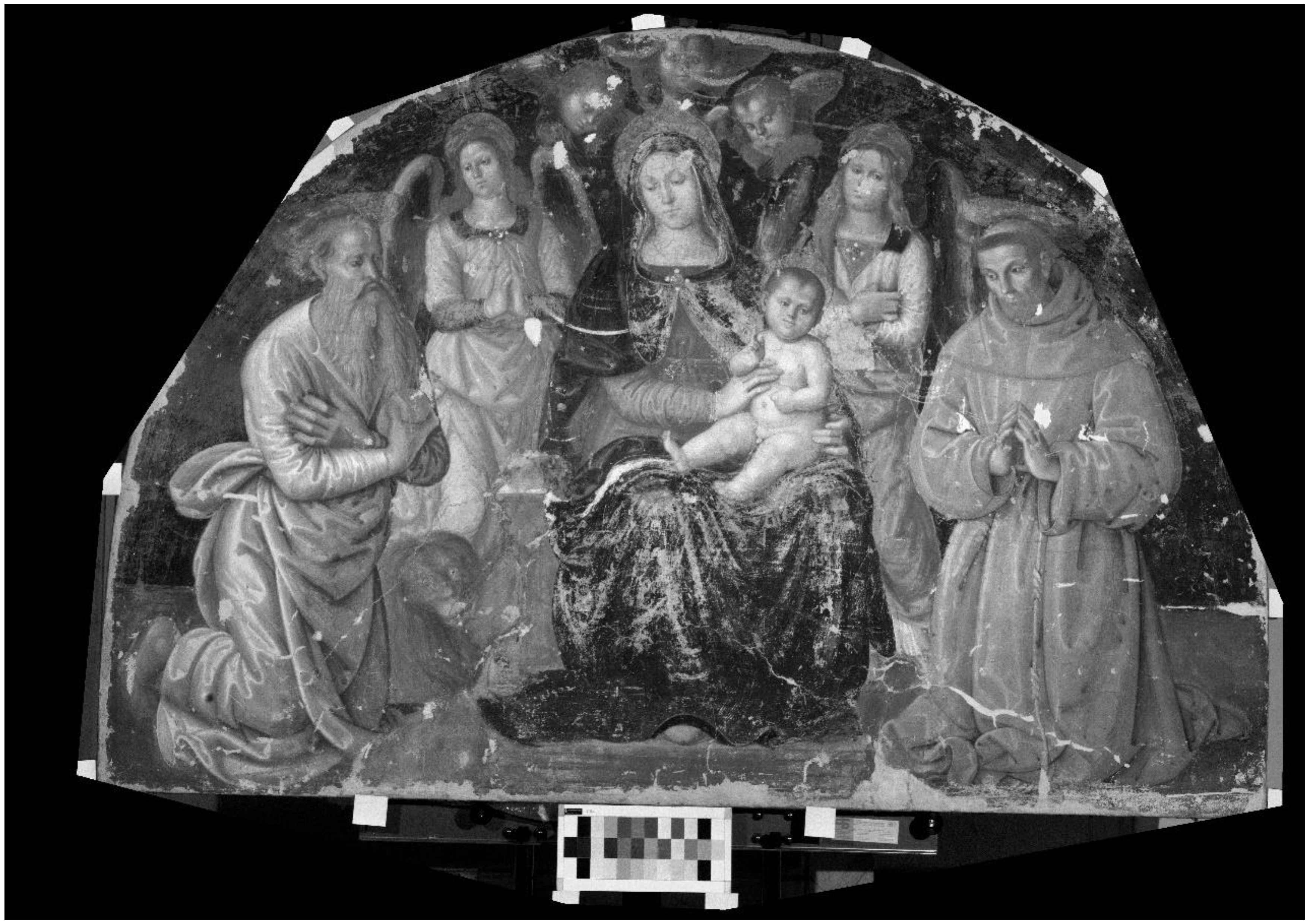
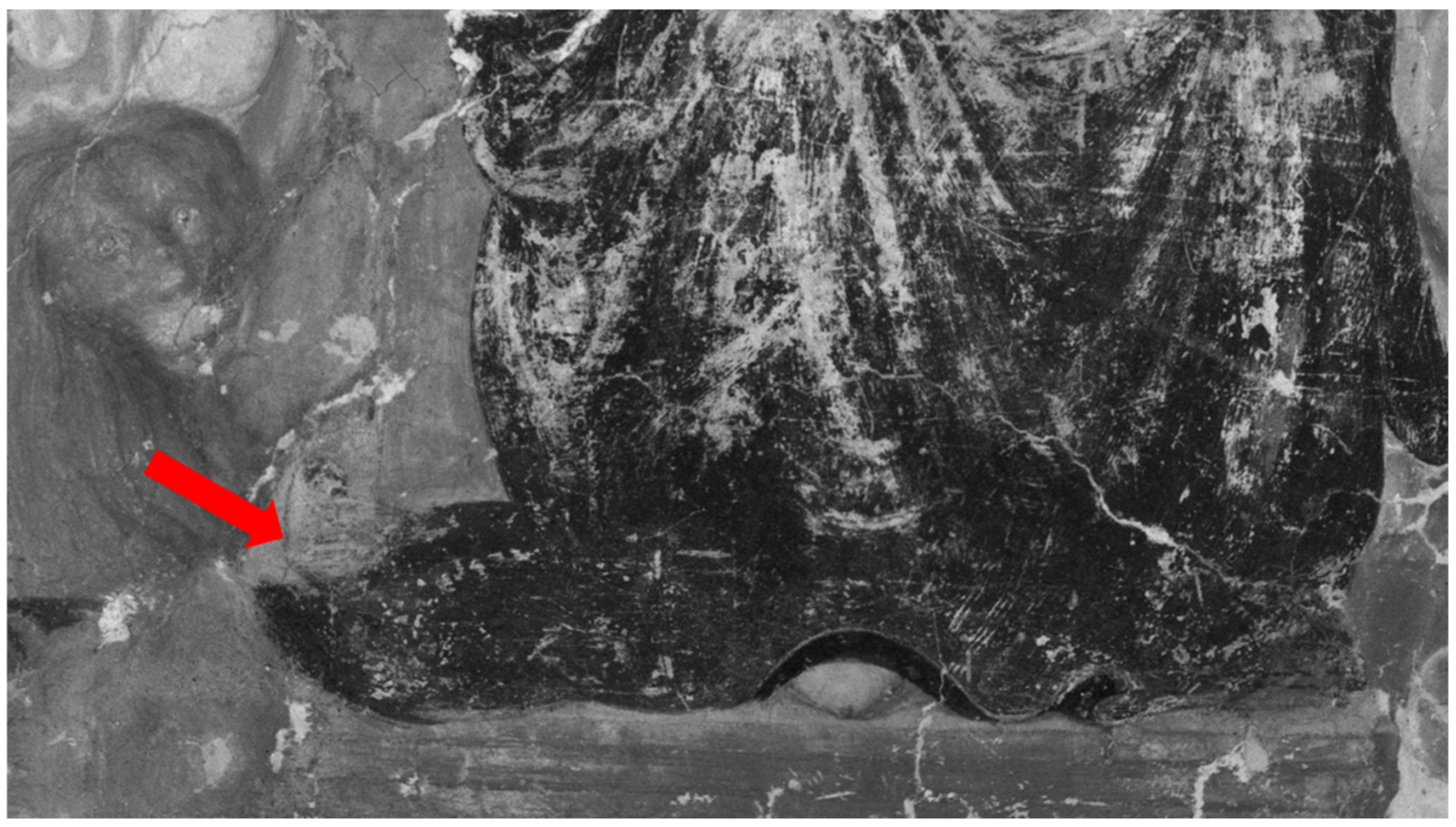
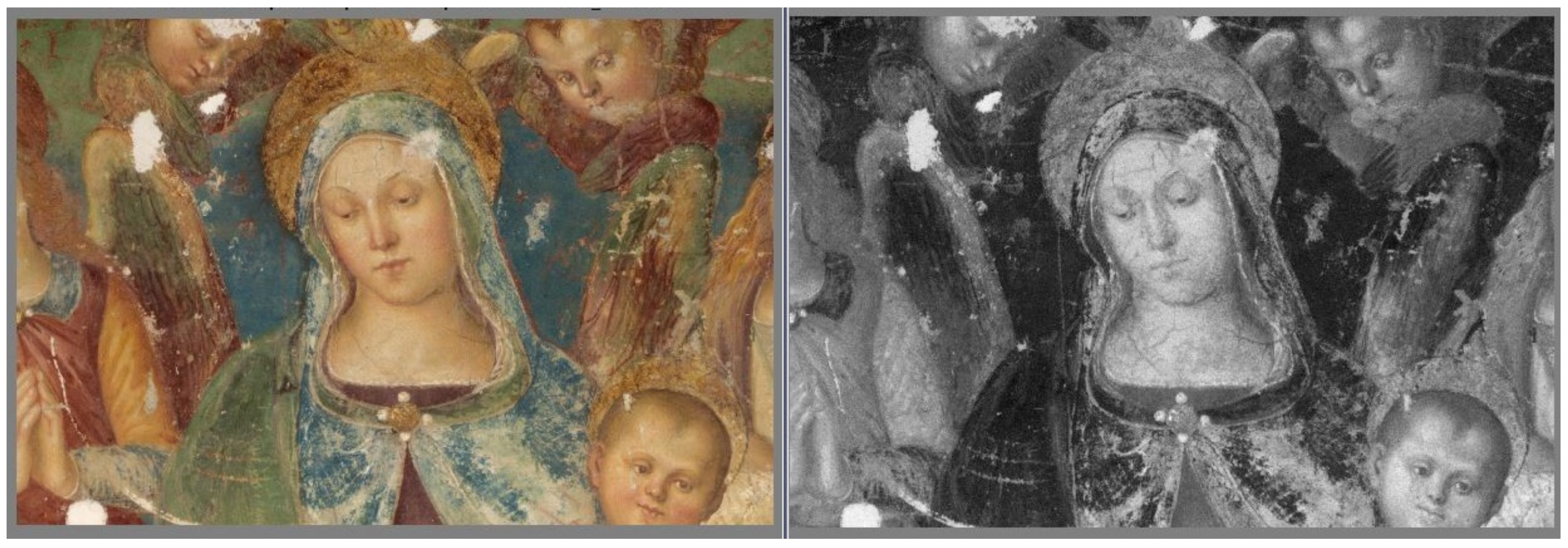
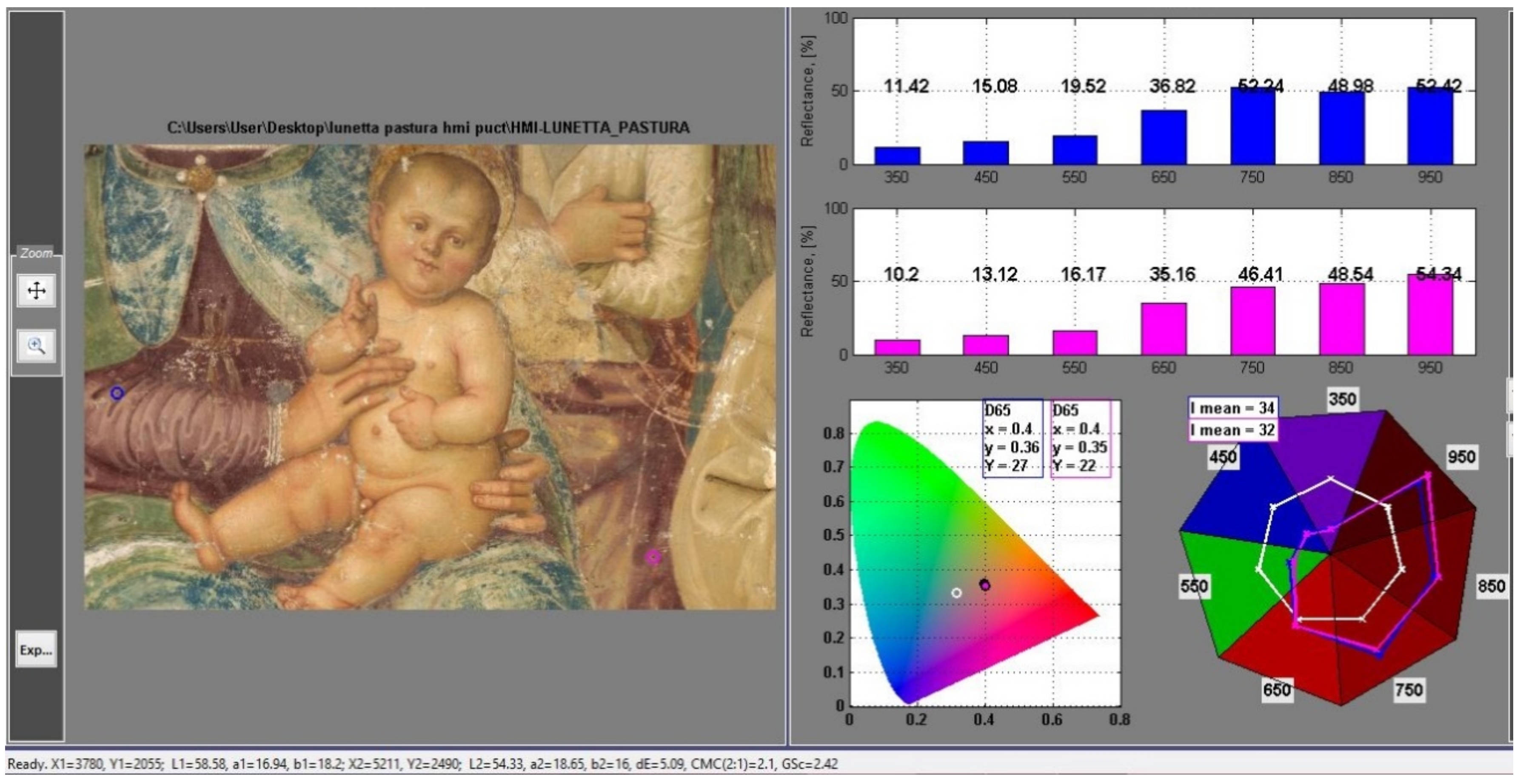

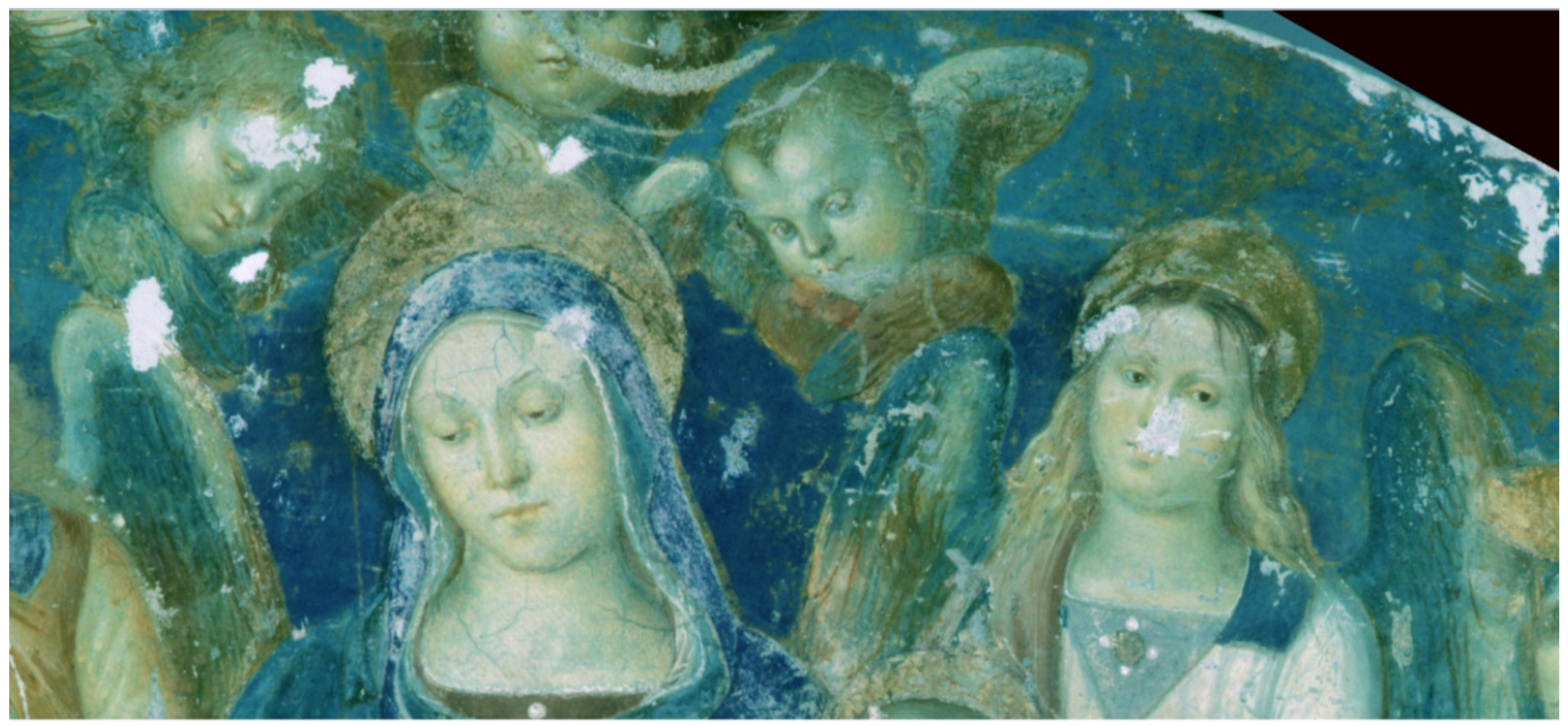
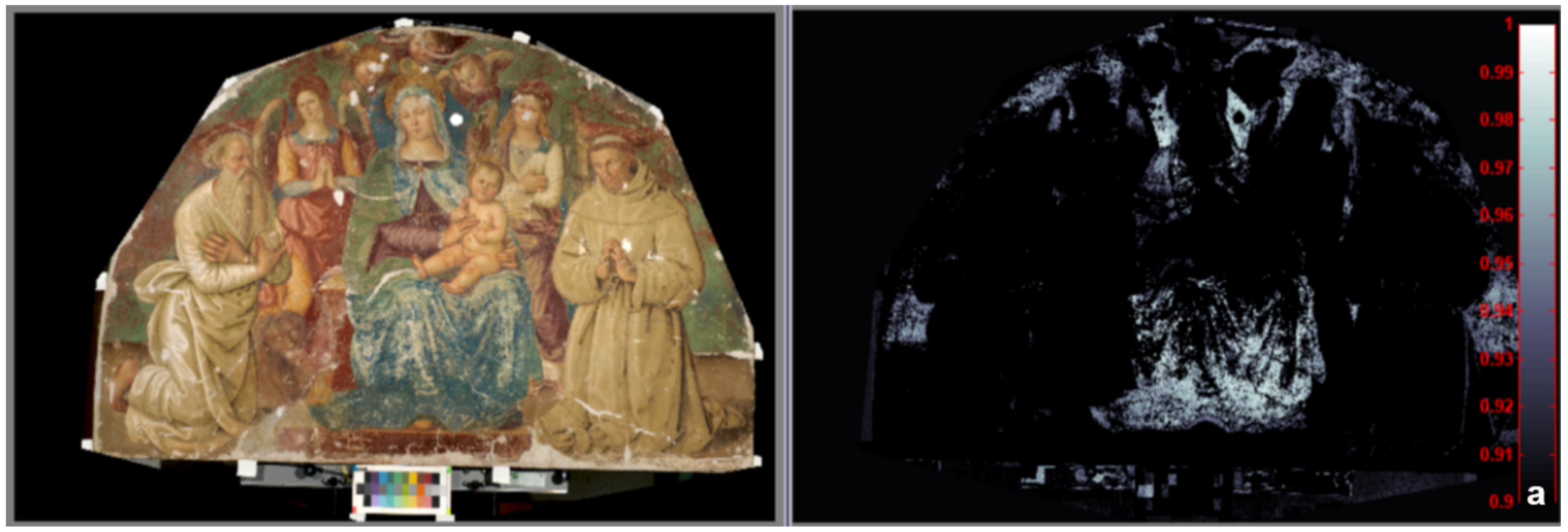
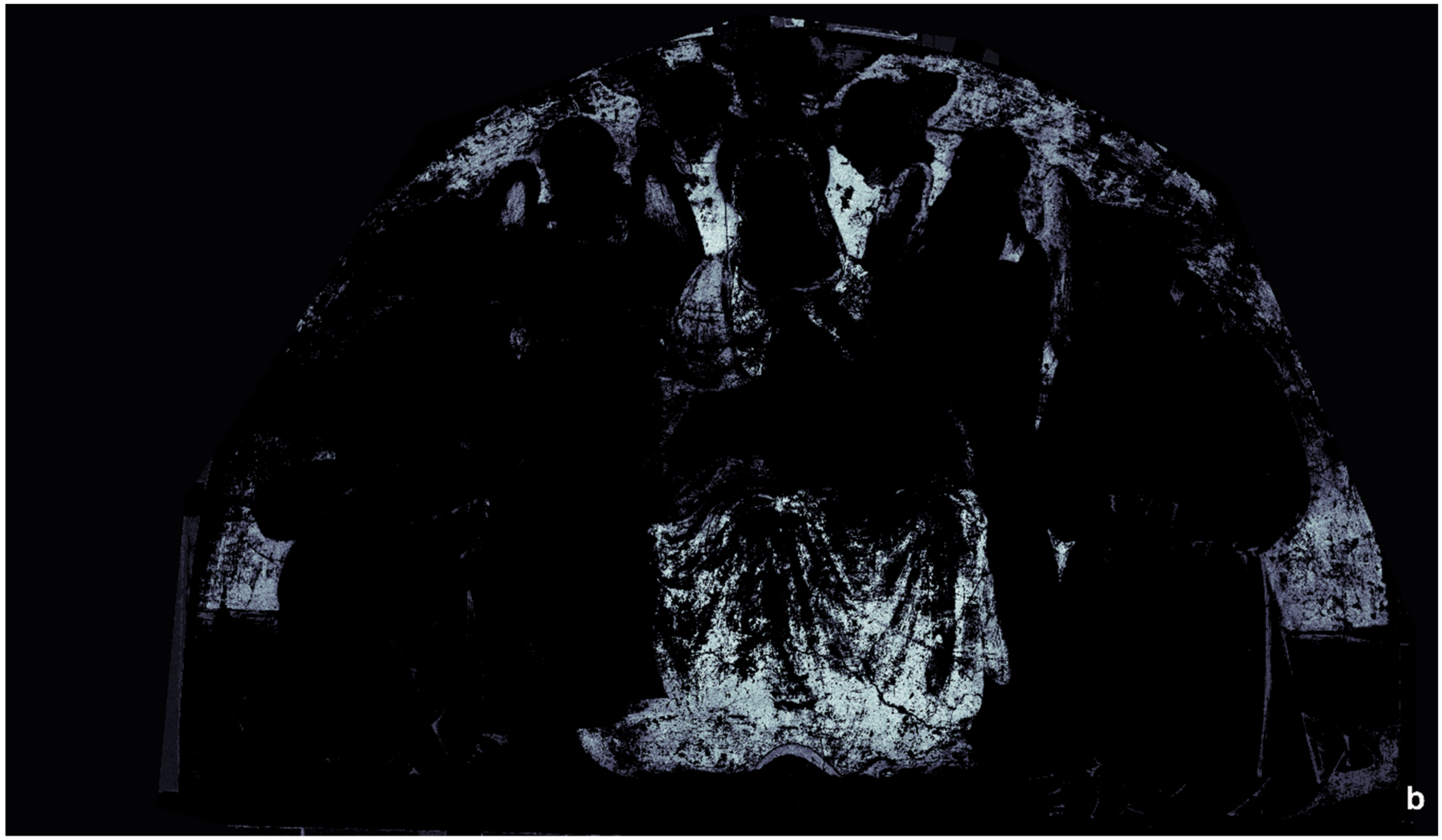
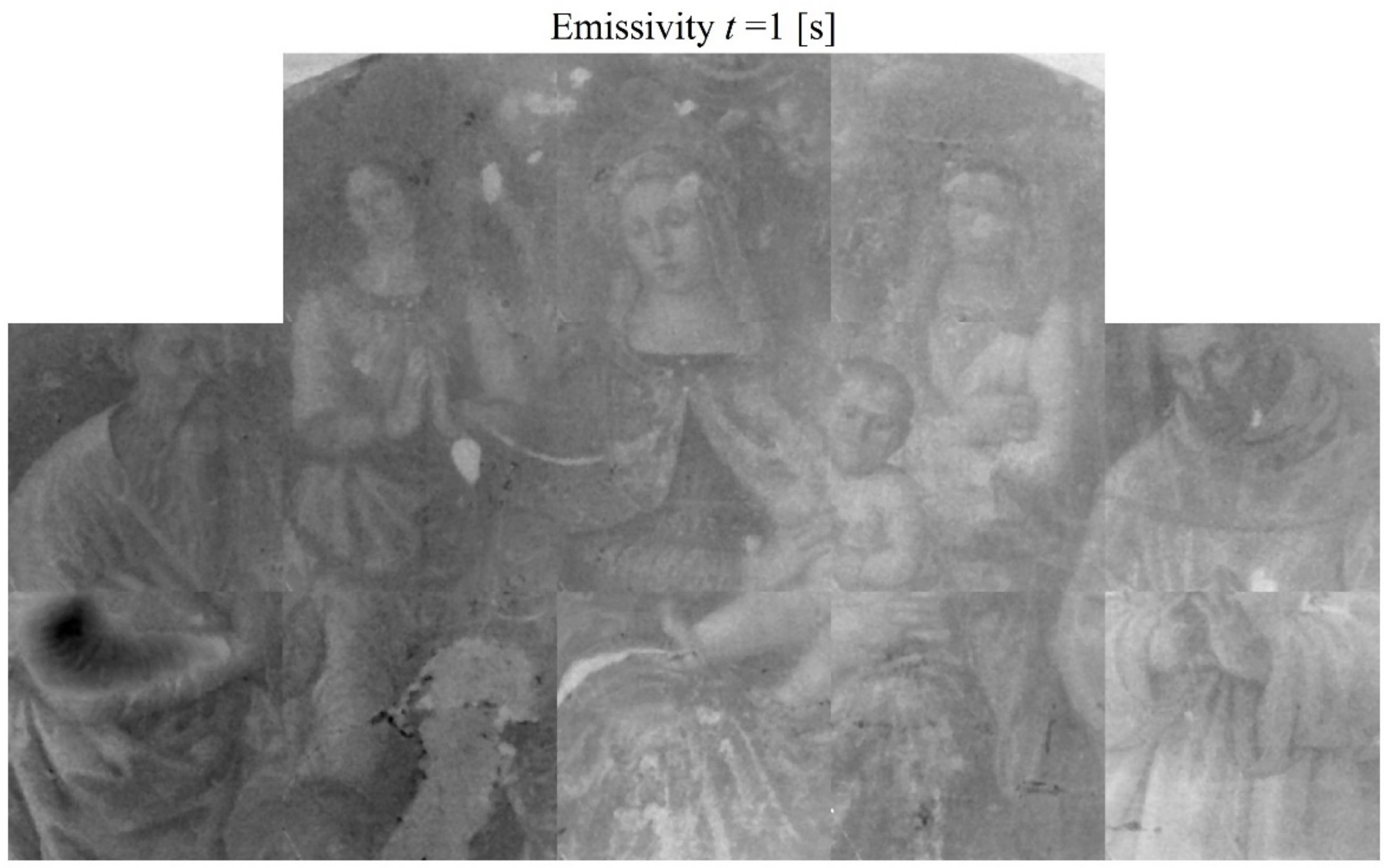

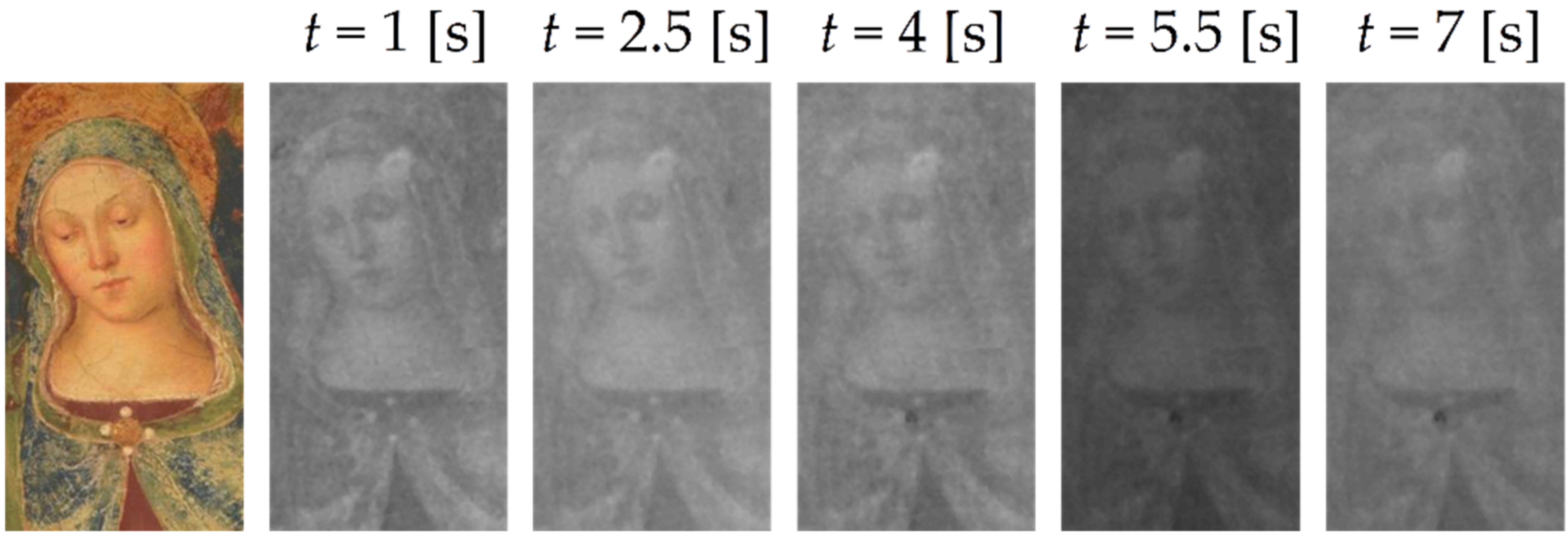
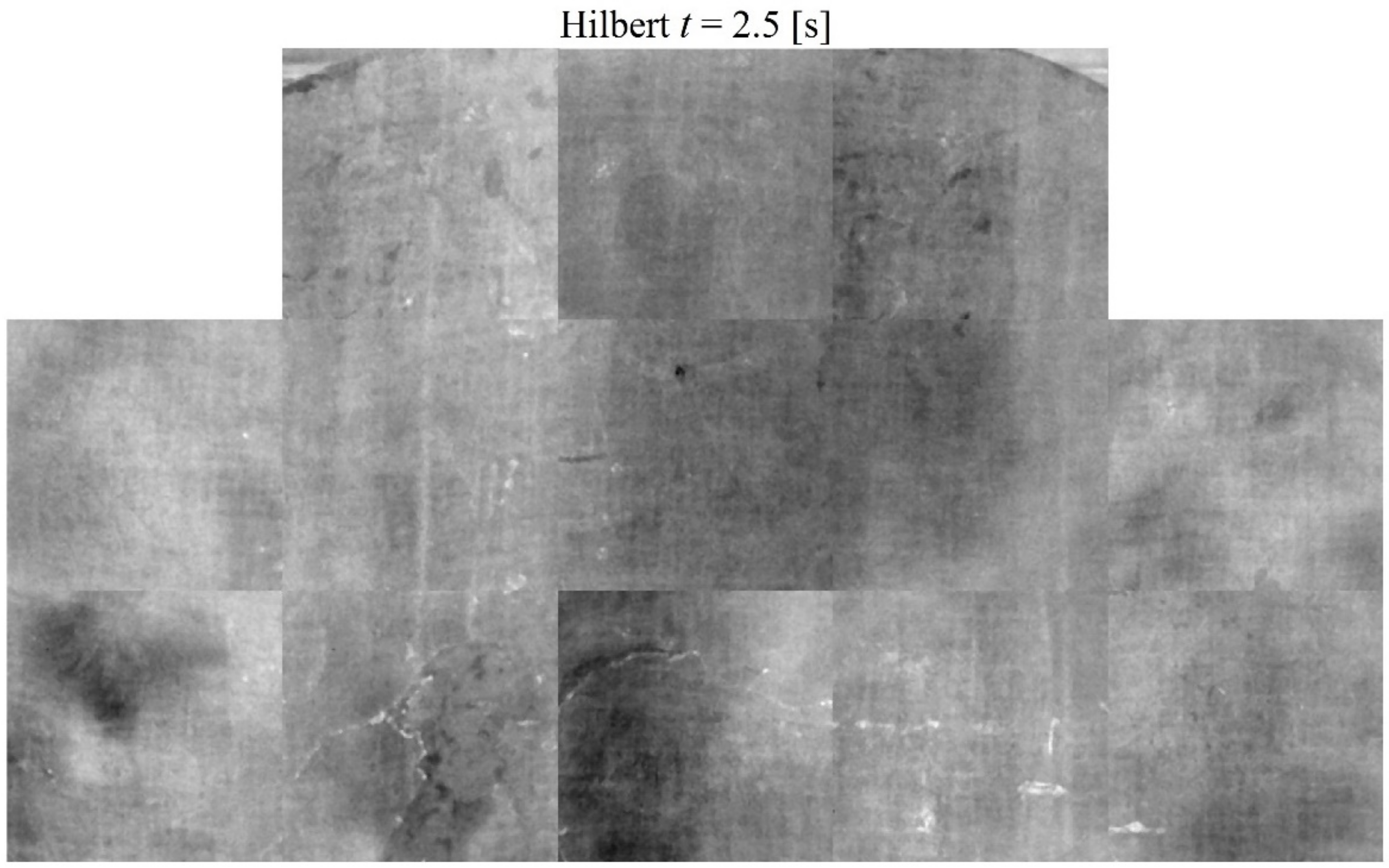
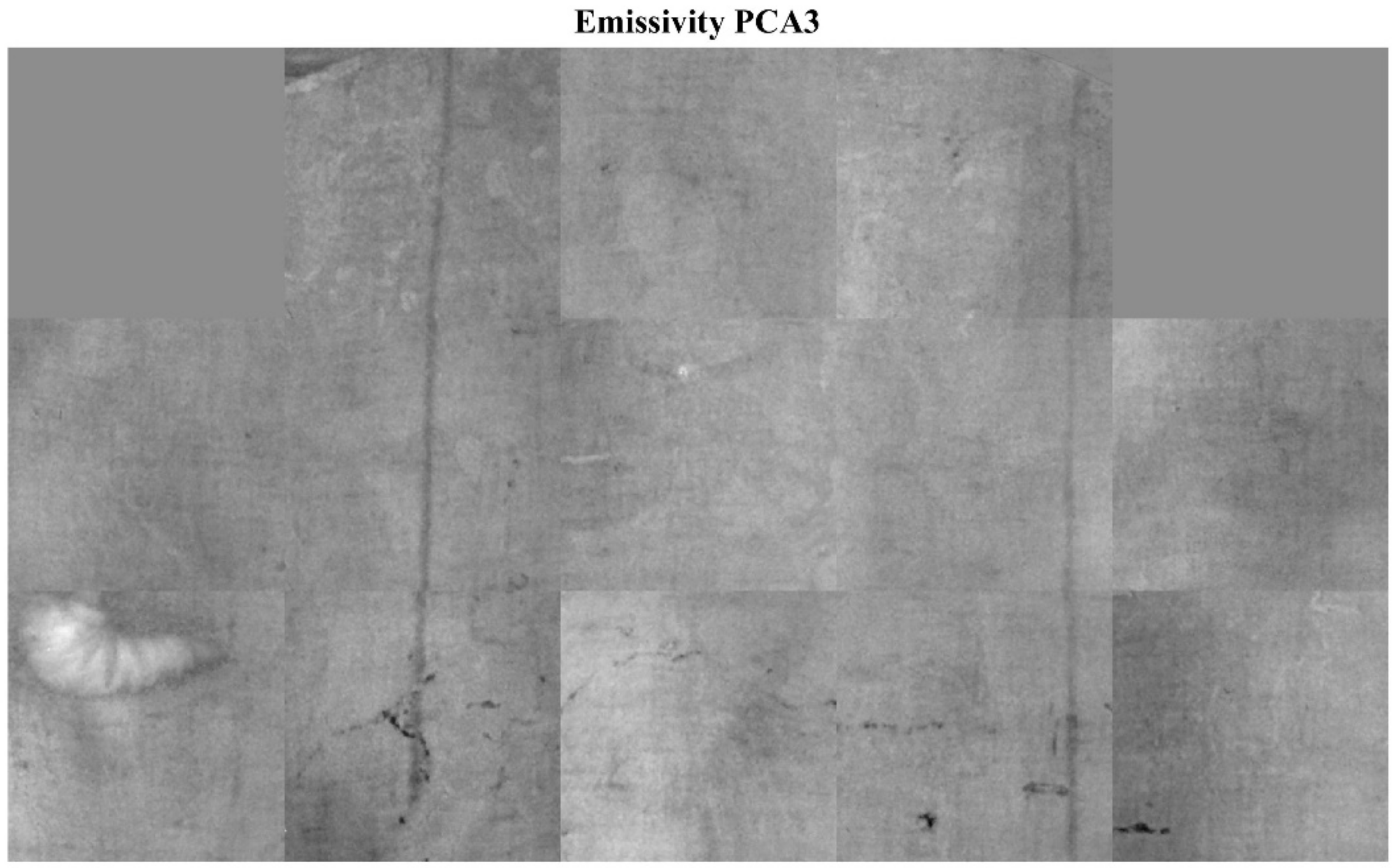
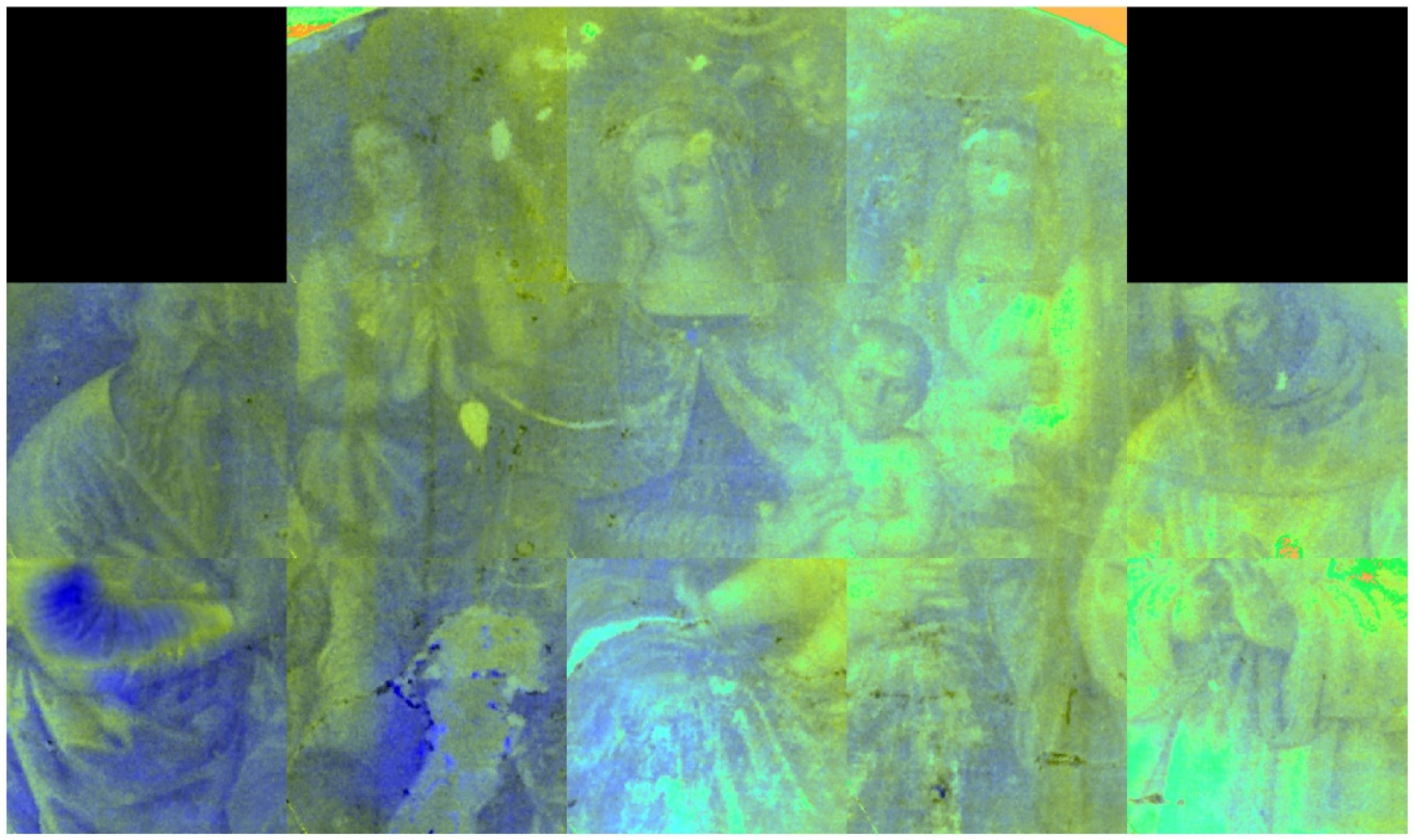
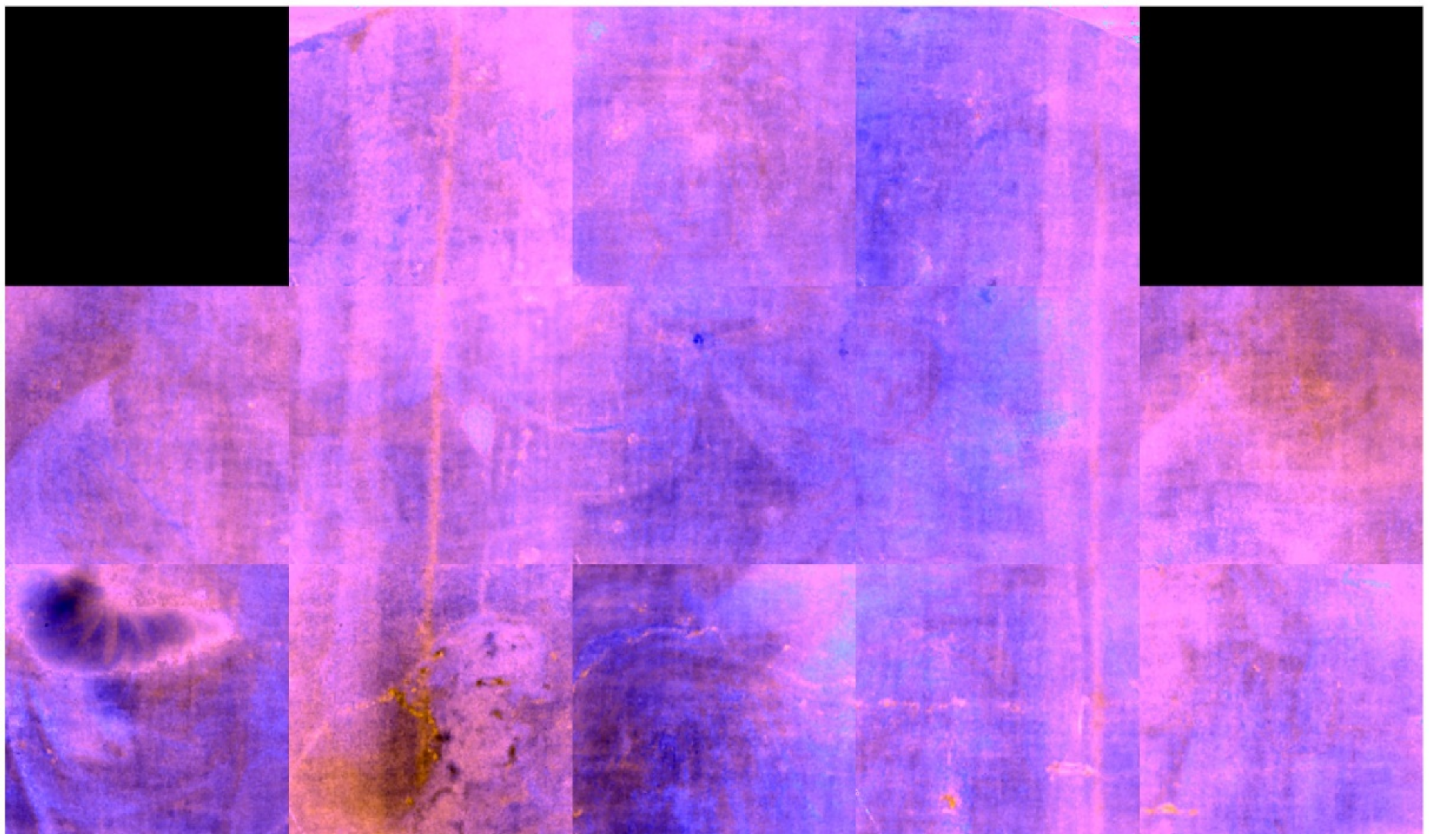
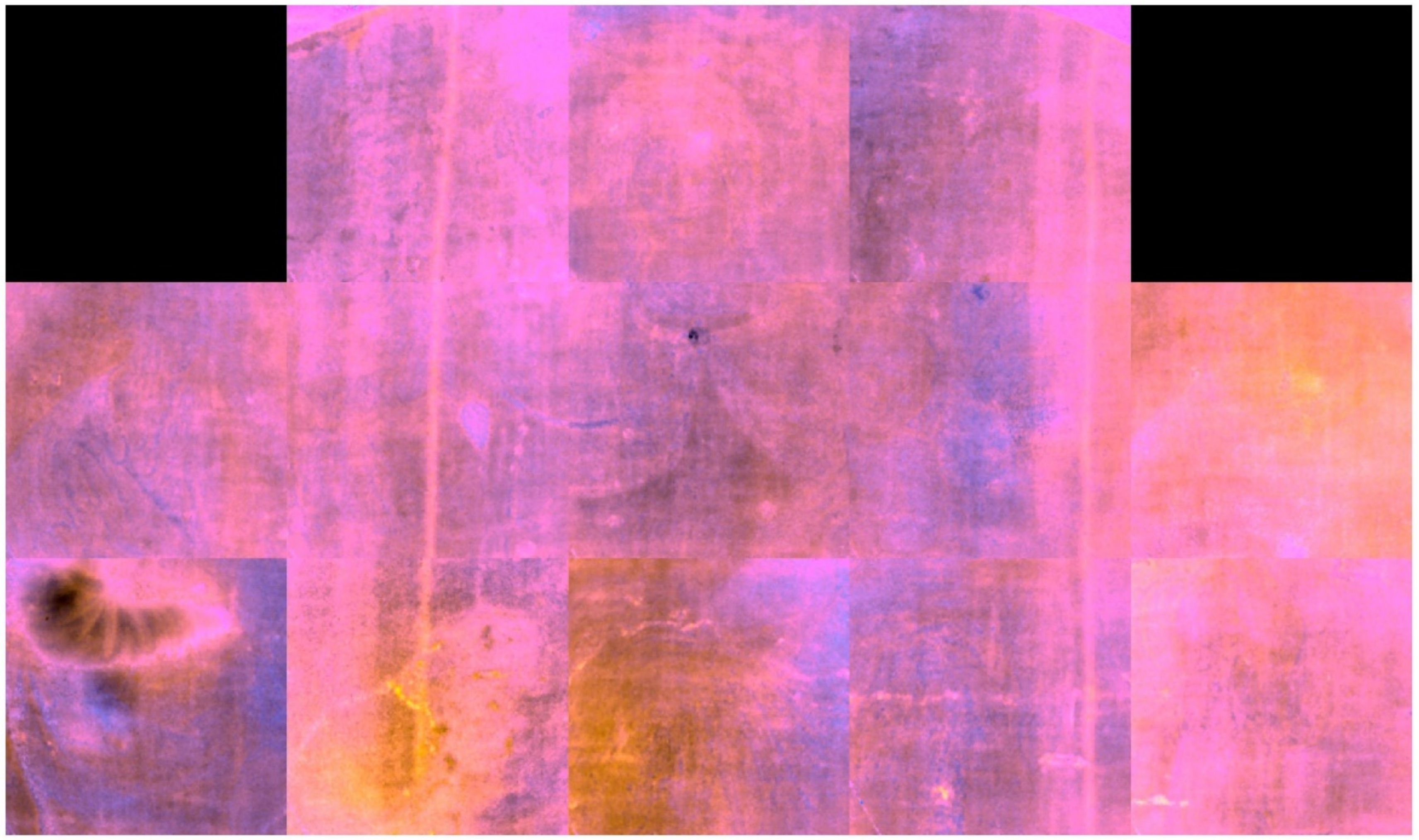
| Ref. | Authors | Title and Year | Investigated Samples | Employed Techniques | Main Findings |
|---|---|---|---|---|---|
| 3 | Aldrovandi, A. et al. | “Multispectral Image Processing Of Paintings”, 1988. | Test panel; Tempera painting. | Reflectographic apparatus (0.7–1 µm), equipped with an image processor. | Demonstrating the discrimination of both pigments and overpainting via multispectral imaging. |
| 4 | Saunders, D. et al. | “A New Camera for High-Resolution Infrared Imaging of Works of Art”, 2006. | Underdrawings test chart; “The Adoration of the Name of Jesus” by El Greco; “The Virgin and Child with Saints Jerome and Francis” by Perugino. | Scanning Infrared Imaging System (SIRIS), 0.9–1.7 µm. | A modified camera based on a commercially available 320 × 256 pixel InGaAs was realised, and its capability to scan quickly large painted areas demonstrated. |
| 5 | Fischer, C., Kakoulli, I. | “Multispectral and hyperspectral imaging technologies in conservation: Current research and potential applications”, 2006. | Review Paper. | Review Paper on multispectral imaging. | A literature review concerning the application of multispectral and hyperspectral imaging for the study and conservation of artworks (from visible to mid infrared (up to 15 µm)). |
| 6 | Delaney, J. K. et al. | “Visible and Infrared Imaging Spectroscopy of Picasso’s Harlequin Musician: Mapping and Identification of Artist Materials in Situ”, 2010. | “Harlequin Musician” by Pablo Picasso. | Hyperspectral cameras (0.441–1.680 µm); Luminescence imaging spectroscopy; X-Ray fluorescence spectrometry; Polarized light microscopy; scanning electron microscopy-energy dispersive spectrometry. | Primary colorants can be successfully identified and mapped using Hyperspectral cameras covering the ShortWave InfraRed (SWIR) spectrum and luminescence imaging spectroscopy. |
| 7 | Adam, A. J. L. et al. | “TeraHertz imaging of hidden paint layers on canvas”, 2009. | Test specimens. | Terahertz imaging; X-rays; SIRIS system. | Terahertz time resolved reflectography can image hidden painting layers and measures their optical thickness. |
| 8 | Fukunaga, K., Piccolo, M. et al. | “Terahertz spectroscopy applied to the analysis of artists’ materials”, 2010. | Test specimens. | Fourier Transform-based Terahertz systems. | Building an online database containing (to date) >1500 spectra of different artists’ materials, in both transmission and reflection mode |
| 9 | Casini, A. et al. | “Fiber optic reflectance spectroscopy and hyper-spectral image spectroscopy: Two integrated techniques for the study of the Madonna dei Fusi”, 2005. | “Madonna of the Yarnwinder”(Lansdowne), attributed to Leonardo da Vinci. | Fiber optics reflectance spectroscopy; image spectroscopy. | A good match with several other non-invasive techniques applied on the same painting was found in terms of pigments, preparatory layer, and binding medium’ identification. |
| 10 | Elias, M. et al. | “Review of several optical non-destructive analyses of an easel painting. Complementarity and crosschecking of the results”, 2011. | “Portrait of lady” by Franz Strotszberg. | Multispectral imaging; optical coherence tomography; goniophometry; UV-fluorescence emission spectroscopy; diffuse reflectance spectroscopy. | Results from the different techniques are shown to be complementary to each other—their crosschecking leads to an in-depth understanding of the painting. |
| 11 | Luciani, G. et al. | “How to reveal the invisible the fundamental role of diagnostics for religious painting investigation”, 2019. | Panel painting from a private collection. | Video microscope; infrared reflectography; UV fluorescence photography, X-ray fluorescence spectroscopy; radiography. | The combined use of these techniques revealed a preserved painting hidden by the landscape representation. |
| 12 | Lanteri, L. et al. | “A New Practical Approach for 3D Documentation in Ultraviolet Fluorescence and Infrared Reflectography of Polychromatic Sculptures as Fundamental Step in Restoration”, 2019. | A 17th century reliquary bust representing St. Rodonio. | Modified Nikon D5300 SLR camera and a modified digital camera Samsung NX3300 for UV fluorescence and infrared photography. | Generating a 3D model of the inspected sample, containing UV and infrared information. |
| 13 | Colantonio, C. et al. | “Hypercolorimetric multispectral imaging system for cultural heritage diagnostics: An innovative study for copper painting examination,” 2018. | A 17th century oil painting, originally positioned in S. Giuliano monastery in L’Aquila, Italy. | Hypercolorimetric Multispectral Imaging (0.3–1 µm). | A degradation map of the paintings’ layers has been produced, representing a potential decision-making tool for the conservators. |
| 14 | Pelosi, C. et al. | “An integrated approach to the conservation of a wooden sculpture representing Saint Joseph by the workshop of Ignaz Günther: Analysis, laser cleaning, and 3D documentation”, 2016. | An 18th century wooden sculpture representing Saint Joseph by the workshop of Ignaz Günther. | Optical microscopy; micro-Raman; Fourier transform infrared (FTIR) spectrometry. | The techniques have been used to inspect the painting and monitor the laser cleaning procedure applied onto the wooden surface. |
| 15 | Lo Monaco, A. et al. | “The triptych of the Holy Saviour in the Tivoli Cathedral: Diagnosis, conservation, and religious requirements”, 2015. | “Holy Saviour” panel painting in Tivoli’s Cathedral, Rome, Italy (12th century). | Video microscope; infrared reflectography; false colour infrared photography; X-ray fluorescence spectroscopy. | The use of valuable materials and pigments such as gold, vermilion, ultramarine blue has been shown. The analyses allowed the dating of the panel painting. |
| 16 | Pelosi, C. et al. | “Investigation of a medieval illuminated manuscript through non-invasive techniques”, 2017. | The so-called ‘Saint Thomas’ Bible, stored in “Ardenti Library”, Viterbo, Italy (13th century). | X-ray fluorescence spectroscopy; visible reflectance spectrophotometry; infrared reflectography; false colour infrared and ultraviolet fluorescence digital photography; video microscope acquisitions. | Pigments have been identified as well as possible non-original interventions on the Bible. |
| 17 | Vetter, W., Schreiner, M. | “characterization of pigment-binding media systems—comparison of non-invasive in situ reflection ftir with transmission ftir microscopy”, 2011. | Test samples; two paintings on paper “Heute verliebt, morgen betrübt” and an untitled one, both by Franz West. | Reflection FTIR spectroscopy; FTIR microscope. | Most of the pigments have been succesfully identified with a reflection FTIR device, which is portable and it can be used in situ, and the results validated with FTIR microscope. |
| 18 | Ricciardi, P. et al. | “Near infrared reflectance imaging spectroscopy to map paint binders in situ on illuminated manuscripts”, 2012. | A 15th century illuminated manuscript leaf on parchment representing the “Praying Prophet” by Lorenzo Monaco. | Hyperspectral near infrared imaging spectrometer (1.0–2.5 µm); FTIR; fiber optic spectroradiometer; gas chromatography/mass spectrometry. | An unexpected use of egg yolk tempera was found. |
| 19 | Legrand, S. et al. | “Non-invasive analysis of a 15th century illuminated manuscript fragment: Point-based vs. imaging spectroscopy”, 2018. | Don Silvestro dei Gherarducci, “St Clement in a historiated initial D”, dated within 1370–1375, The Fitzwilliam Museum, Cambridge, UK. | Macroscopic X-Ray fluorescence. macroscopic reflection mode (FTIR) scanning. | Identification of different lead compounds and gildings, in a total non-invasive way. |
| 20 | Mancini, D. et al. | “On-site contactless surface analysis of Modern paintings from Galleria Nazionale (Rome) by Reflectance FTIR and Raman spectroscopies”, 2021. | Seven artworks by J. Albers, A. Bonalumi, L. Boille, T. Scialoja, and M. Schifano, Galleria Nazionale di Arte Moderna, Rome, Italy. | Specular Reflectance Infrared Spectroscopy; Raman spectroscopy (SR-FTIR). | Acrylic, vinylic, oil media, and enamal paints have been succesfully identified with SR-FTIR, with or without opacifiers. |
| Point and Colour | Detected Elements | Hypothesized Pigments on the Base of XRF Data |
|---|---|---|
| X1—Blue of the Virgin garment | Cu (main), Ca, Fe, Sr | Copper based pigment, probably azurite, red ochre |
| X2—Green of the Virgin mantle | Cu (main), Ca, Fe, Sr, Pb | Copper based green, probably malachite, red ochre |
| X3—White of the Virgin jewel | Ca (main), Fe, Sr, Cu (tr) | Ca white |
| X4—Yellow of the Virgin jewel | Ca (main), Fe, Au, Pb, Sr | Gold on missione with siccative Pb-based pigments |
| X5—Blue of the background near the Virgin head | Cu (main), Fe, Ca, Sr (tr), Pb (tr) | Copper based pigment, probably azurite, red ochre |
| X6—Yellow of the angel arm | Ca (main), Fe, Sr | Yellow ochre |
| X7—Gold yellow of angel jewel | Ca, Fe, Au, Pb, Sr | Gold on missione with siccative Pb- and Fe-based pigments |
| X8—Red of angel garment | Ca (main), Fe, Sr | Red ochre |
| X9—Dark red, “morellone”, of the Virgin garment | Fe (main), Ca, Sr | Fe-based pigment, probably morellone |
| X10—Child cheek | Ca (main), Fe, Sr | Ca white and red ochre |
| X11—Gold yellow of the Child halo | Ca (main), Fe, Sr, Au, Pb, Mn (tr) | Gold on missione with siccative Pb- and Fe-based pigments |
| X12—Red background at the bottom right | Ca, Fe, Cu, Sr | Copper based pigment on red ochre |
| X13—Green background at the bottom right | Cu, Ca, Fe, As, Cl, Sr | Retouching area (Emerald green) |
| X14—Blue background at the bottom right | Cu (main), Ca, Fe, Sr | Copper based pigment on red ochre |
| X15—Dark brown of St. Francis habit | Ca, Fe, Mn, Sr, Br | Umber pigment due to the presence of Mn |
Publisher’s Note: MDPI stays neutral with regard to jurisdictional claims in published maps and institutional affiliations. |
© 2021 by the authors. Licensee MDPI, Basel, Switzerland. This article is an open access article distributed under the terms and conditions of the Creative Commons Attribution (CC BY) license (https://creativecommons.org/licenses/by/4.0/).
Share and Cite
Ricci, M.; Laureti, S.; Malekmohammadi, H.; Sfarra, S.; Lanteri, L.; Colantonio, C.; Calabrò, G.; Pelosi, C. Surface and Interface Investigation of a 15th Century Wall Painting Using Multispectral Imaging and Pulse-Compression Infrared Thermography. Coatings 2021, 11, 546. https://doi.org/10.3390/coatings11050546
Ricci M, Laureti S, Malekmohammadi H, Sfarra S, Lanteri L, Colantonio C, Calabrò G, Pelosi C. Surface and Interface Investigation of a 15th Century Wall Painting Using Multispectral Imaging and Pulse-Compression Infrared Thermography. Coatings. 2021; 11(5):546. https://doi.org/10.3390/coatings11050546
Chicago/Turabian StyleRicci, Marco, Stefano Laureti, Hamed Malekmohammadi, Stefano Sfarra, Luca Lanteri, Claudia Colantonio, Giuseppe Calabrò, and Claudia Pelosi. 2021. "Surface and Interface Investigation of a 15th Century Wall Painting Using Multispectral Imaging and Pulse-Compression Infrared Thermography" Coatings 11, no. 5: 546. https://doi.org/10.3390/coatings11050546
APA StyleRicci, M., Laureti, S., Malekmohammadi, H., Sfarra, S., Lanteri, L., Colantonio, C., Calabrò, G., & Pelosi, C. (2021). Surface and Interface Investigation of a 15th Century Wall Painting Using Multispectral Imaging and Pulse-Compression Infrared Thermography. Coatings, 11(5), 546. https://doi.org/10.3390/coatings11050546













